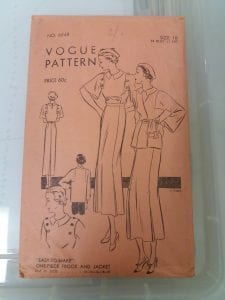
MA Design History Material Culture Victoria Haddock reports on receiving the Costume Society’s 2018 Yarwood Award

Figure 1: Easy Lessons in Dressmaking article from Fashion Service: Woman’s Institute Magazine (January 1931) from the collections of the Royal Albert Memorial Museum. Photograph taken by the author.
I am currently writing my History of Design and Material Culture MA dissertation on the topic of dress patterns, and the influence that Hollywood film costumes of the 1930s had on the pattern industry. I am particularly interested in film costumes worn by the actress Katharine Hepburn, and am focusing my research on two of her films from the 1930s, Christopher Strong(1933) and Alice Adams (1935). Both of these films featured costumes that were produced and sold as dress patterns by the Hollywood Pattern Company and Butterick Starred Patterns. By analyzing these dress patterns, and recreating the jacket from a copy of the Butterick Starred Pattern that I have been able to purchase, I hope to discover more about the dressmaking skills of women of the period and how easy these patterns were to construct. I aim to find out how much of an influence Hollywood stars such as Hepburn, were on women and whether the designs had any impact on the fashion trends of the decade.

Figure 2: Can the Stars Choose Clothes? by Pat Wallace, The Picturegoer (February 1930) from the collections of the Bill Douglas Cinema Archive, Exeter University. Photograph taken by the author.
My research so far has taken me to varied museums and collections across the country, and even to one in America that I’ve been able to access from the comfort of my own home! I have been to look at 1930s film magazines in the Bill Douglas Cinema Museum Archive at Exeter University, read through first hand accounts of 1930s fashion and dressmaking trends in the Mass Observation Archive at The Keep and researched the impact of celebrity dress in the V&A’s Vivien Leigh Archive at Blythe House. I have also investigated examples of 1930s Hollywood ‘tie-ins’ in the V&A’s costume collection, looked at patterns and sewing magazines at the Royal Albert Memorial Museum in Exeter and viewed examples of 1930s dress in the costume collection at the National Trust’s Killerton House in order to find evidence of Hollywood’s permeation of 1930s fashions. The online Commercial Pattern Archive from The University of Rhode Island has proved to be an extremely useful database for searching patterns and looking at the different styles of garments that were produced for home sewers. I was introduced to the archive through Joy Spanabel Emery’s book A History of the Paper Pattern Industry: The Home Dressmaking Fashion Revolution.

Figure 3: The Glass of Fashion article, Picturegoer Weekly (May 14 1932) from the collections of the Bill Douglas Cinema Archive, Exeter University. Photograph taken by the author.
I am very fortunate recently to have received The Costume Society’s Yarwood Award, 2018, which commemorates the work of costume historian Doreen Yarwood, by helping an MA student with expenditure relating to their dissertation. Through getting this award, I can now finance more research visits to collections that I have since discovered have links with my dissertation topic and I am planning to visit Worthing Museum and the Museum of London very soon. I would like to find more examples of dress that I can match to patterns produced in the 1930s and I am also on the lookout for any rare examples of clothes copied from film costume designs that were manufactured and sold through tie-ins with the big Hollywood studios. I would appreciate any advice if anyone knows of an archive or collection that would be particularly useful to my research.
V.Haddock1@uni.brighton.ac.uk
